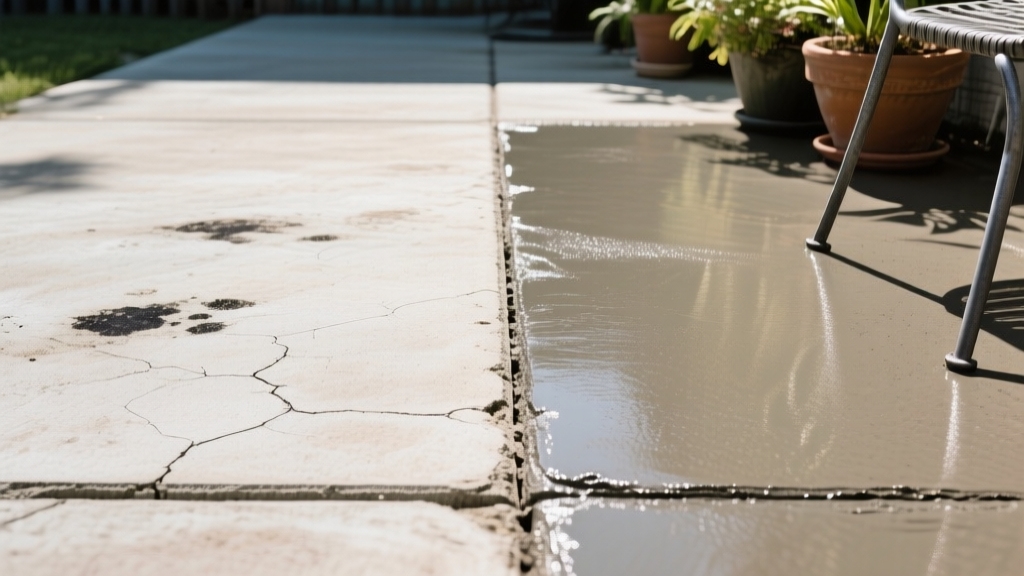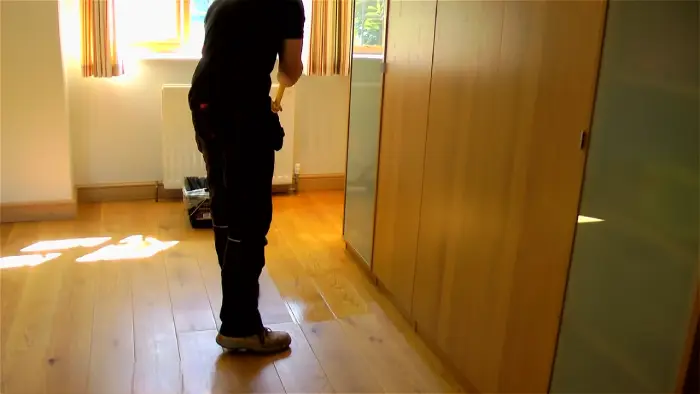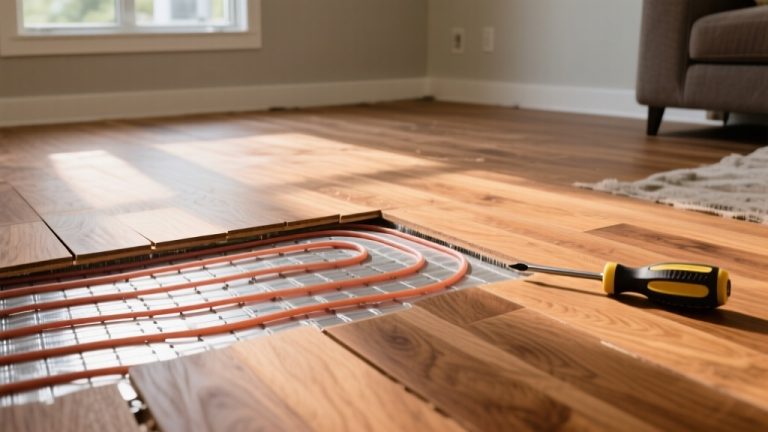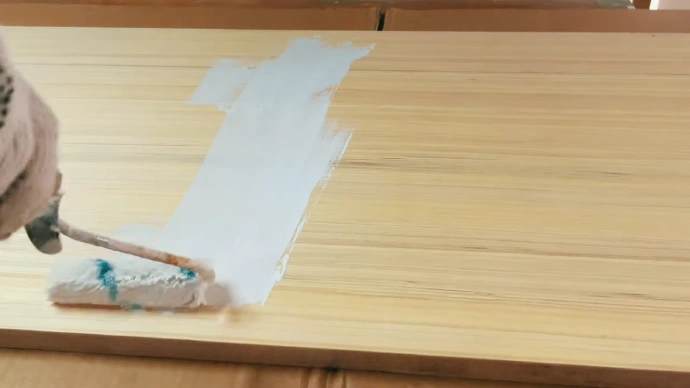Do You Need to Seal Concrete: Durability & Preserve Beauty
You should seal concrete to protect it from water damage, stains, chemicals, and UV exposure that degrade its strength and appearance over time.
Sealing creates a barrier that prevents moisture infiltration, freeze-thaw damage, and surface wear, extending the concrete’s lifespan and reducing maintenance needs.
It also enhances color and slip resistance depending on the sealer type used. Understanding your climate and usage will help you select the most suitable sealer for lasting performance and protection.
Key Takeaways
- Sealing concrete protects against water damage, freeze-thaw cracks, chemical stains, and UV discoloration, extending surface lifespan and durability.
- Outdoor concrete in cold, wet climates especially benefits from penetrating sealers for moisture and salt resistance.
- High-traffic or chemically exposed indoor concrete requires durable film-forming sealers like epoxy or polyurethane.
- Sealing enhances appearance by preserving color, preventing stains, and facilitating easier maintenance.
- Regular sealing and maintenance reduce repair needs, support sustainability, and improve surface safety by preventing mold and slip hazards.
Reasons to Consider Sealing Your Concrete
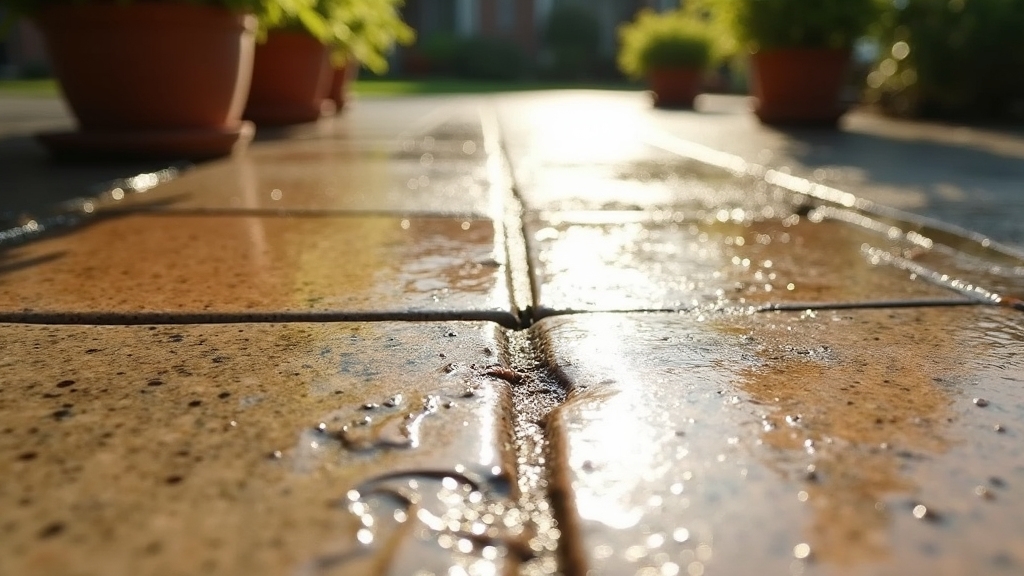
There are five key reasons to contemplate sealing your concrete: protection from water damage, enhanced durability, improved appearance, easier maintenance, and increased safety.
Sealing blocks water penetration, preventing internal cracking and freeze-thaw damage while inhibiting mold growth. It also repels chemicals that corrode steel reinforcement, extending structural integrity. Proper maintenance of sealed surfaces can significantly reduce airborne dust and debris accumulation.
Sealing prevents water damage, mold growth, and corrosion, preserving concrete’s strength and durability.
You’ll notice sealed concrete resists chipping and surface wear better under stress, reducing costly repairs. Additionally, sealing increases resistance to cracking and wear, which further prolongs the concrete’s lifespan. Aesthetically, sealers restore color vibrancy, prevent stains, and protect against UV discoloration.
Maintenance becomes simpler as sealed surfaces repel dirt and spills, making cleaning quicker and more effective. Using gentle cleaning methods regularly helps maintain the surface without causing damage.
Finally, safety improves since sealers can reduce slip hazards and minimize mold-related risks. This added protection aligns with best practices for preserving floor integrity and preventing accidents.
Types of Concrete Sealers and Their Uses
Choosing the right type of sealer depends on the specific needs of your concrete surface and its exposure conditions.
Penetrating sealers like silane, siloxane, and siliconate chemically bond within pores, maintaining a natural look while repelling water and salts. They’re ideal for outdoor driveways, sidewalks, and pool decks. These sealers form breathable silicone membranes that allow vapor to escape while preventing water ingress, which is crucial for long-term durability.
Silicate and colloidal silica densifiers harden surfaces by forming calcium silicate hydrate, enhancing abrasion resistance for industrial floors.
Film-forming sealers, including acrylic, polyurethane, and epoxy, create a protective surface layer that enhances appearance with glossy or satin finishes.
Acrylics are cost-effective and easy to apply. Polyurethanes offer chemical resistance and UV stability. Epoxies provide thick, durable coatings suited for high-traffic areas like garages.
Select your sealer based on durability, appearance, and environmental exposure for superior concrete protection.
How Sealing Protects Concrete From Environmental Damage?
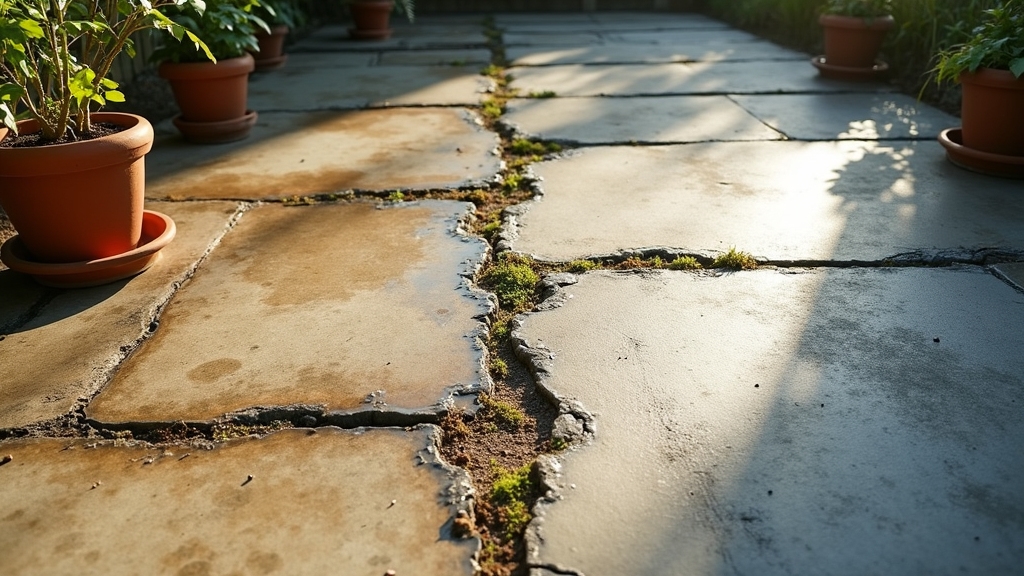
Because concrete is inherently porous, sealing it plays a crucial role in preventing water infiltration that can weaken and deteriorate the material over time.
When you seal concrete, you create a barrier that repels water and blocks contaminants, preserving the material’s integrity.
Here’s how sealing protects your concrete from environmental damage:
- Water and moisture resistance: Sealers reduce water absorption, preventing freeze-thaw damage, cracking, and corrosion of reinforcing steel inside the concrete. Proper timing and application are essential to ensure long-lasting protection.
- Chemical and stain protection: Sealers guard against oils, salts, acids, and other chemicals that cause staining or degrade the concrete’s binder and aggregate.
- UV and pollutant defense: They shield concrete from ultraviolet radiation and environmental pollutants, minimizing surface wear, discoloration, and degradation from sunlight and contaminants.
Sealing extends concrete’s lifespan by preserving its strength and appearance against harsh environmental conditions. Additionally, many modern sealers use natural, biodegradable materials, which reduce environmental impact while maintaining effective protection.
Enhancing Concrete Durability and Appearance With Sealers
While sealing primarily protects concrete, it also substantially enhances its durability and appearance.
Sealers deepen and preserve color, especially on stamped or exposed aggregate surfaces, with acrylic sealers offering glossy finishes that boost vibrancy.
They prevent UV-induced fading and environmental discoloration from rain or freeze-thaw cycles.
You can choose from acrylic, polyurethane, epoxy, or penetrating sealers depending on desired sheen and texture effects.
Penetrating sealers maintain natural looks without gloss, while film-forming types add customizable gloss levels.
Sealers also preserve or improve surface texture and slip resistance, which is essential for safety on wet surfaces.
Additionally, they block stain penetration, simplifying cleaning and maintaining concrete’s fresh appearance.
Proper sealing also helps prevent crack prevention by reducing water infiltration that leads to freeze-thaw damage.
Selecting the right sealer balances aesthetic appeal with functional durability, extending your concrete’s lifespan and keeping it visually attractive. Proper surface preparation and material compatibility are key factors to ensure the effectiveness and longevity of sealers.
Maintenance Requirements for Sealed Concrete Surfaces
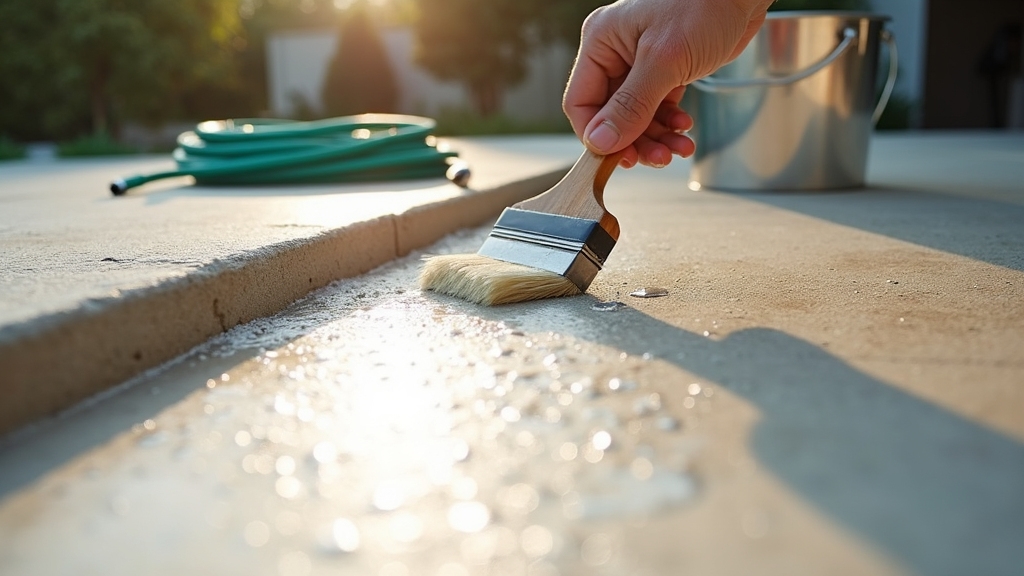
Sealers provide a strong barrier that enhances concrete’s durability and appearance, but maintaining that protection requires regular care.
Sealers strengthen concrete’s durability and look, yet ongoing maintenance is essential to preserve their protective benefits.
To keep sealed concrete surfaces effective, you should:
- Clean regularly using dry dust mopping or wet mopping with a neutral pH cleaner indoors. Use mild detergents or pressure washing outdoors. Quick stain removal prevents damage and preserves appearance. Regular cleaning is essential because it prevents early deterioration and costly repairs. Additionally, inspecting the surface periodically can help identify areas where moisture might penetrate, similar to how you inspect a valve box lid to prevent water entry.
- Monitor for wear signs like dull spots or loss of water repellency. Reseal every few years, or sooner in harsh climates and high-traffic areas. Clean thoroughly before resealing to ensure adhesion. Using a waterproof sealant compatible with the outdoor environment can further enhance protection and longevity.
- Avoid harsh chemicals and use compatible cleaning products to prevent sealer degradation. Consider applying sacrificial wear layers like wax to extend sealer life.
Following these steps ensures your sealed concrete remains durable and visually appealing over time.
Choosing the Right Sealer for Your Climate and Application
When selecting a concrete sealer, consider how your local climate and the surface’s intended use affect performance requirements.
In cold or wet climates with freeze-thaw cycles, opt for silane sealers that penetrate deeply to repel water and resist ice damage. Choosing a sealer that also maintains low VOC emissions can enhance environmental safety.
For porous concrete, siloxane or silane-siloxane hybrids provide effective waterproofing.
Newly placed concrete benefits from siliconate sealers, which act as curing agents and water repellents.
If your surface faces heavy abrasion or chemical exposure, polyurethane sealers form durable, chemical-resistant films suitable for high-traffic areas.
Film-forming sealers like acrylics suit moderate climates and indoor uses but wear faster outdoors.
Penetrating sealers maintain vapor permeability, preventing moisture buildup and spalling in harsh weather. These sealers work by absorbing into the concrete pores, stabilizing and protecting the material without altering its appearance.
Match your sealer chemistry and film characteristics to your environment and use to ensure reliable concrete protection and longevity.
Potential Drawbacks and Limitations of Concrete Sealing
Although concrete sealing offers protection and durability, it comes with potential drawbacks that you need to contemplate. Understanding these limitations helps you make an informed decision about whether sealing suits your needs.
- Moisture Issues: Sealed surfaces can trap moisture underneath, causing bubbling, peeling, or mold growth. Poor-quality or improperly applied sealants may fail to repel water, compromising concrete integrity. Sealants can be susceptible to scratching, especially in high-traffic areas, which can accelerate wear and reduce effectiveness.
- Maintenance Burden: Sealers require periodic reapplication every 1-3 years for acrylics and 5-10 years for epoxy or urethane to maintain protection. High-traffic areas may need more frequent upkeep, increasing labor and cost. Proper surface preparation and maintenance are critical to prevent long-term failure and ensure sealant longevity.
- Surface and Safety Concerns: Sealers can fade under UV exposure and scratch easily. Glossy finishes may create slippery surfaces, posing safety hazards, especially when wet. Some sealants may also react poorly with harsh chemicals or pets. Additionally, some hydrophobic sealants may fail to prevent water ingress, risking damage from moisture and soluble salts drawing moisture through the slab.
Weigh these factors carefully before sealing your concrete.
Environmental and Practical Benefits of Sealing Concrete
Understanding the limitations of concrete sealing helps you weigh its advantages more clearly.
Sealing concrete offers significant environmental and practical benefits. Eco-friendly sealers reduce pollution by using biodegradable materials and low VOCs, improving air quality and minimizing harmful emissions. These products are often certified under standards like Green Seal, LEED, or USDA BioPreferred, ensuring their sustainable performance. Regular maintenance and timely sealing can prevent surface damage and prolong the life of concrete.
Practically, sealed concrete resists moisture, stains, and UV damage, extending surface lifespan and reducing maintenance needs. Additionally, sealing lowers repair frequency, conserving resources and supporting sustainability certifications.
| Environmental Benefits | Practical Benefits |
|---|---|
| Reduces VOC emissions | Repels water and soluble salts |
| Uses renewable, biodegradable materials | Resists staining and abrasion |
| Lowers environmental impact through durability | Extends concrete lifespan |
Sealing concrete protects the environment and enhances durability, making it a smart investment for longevity and sustainability. Proper sealing techniques coupled with preventive maintenance maximize these benefits and reduce long-term repair costs.
Frequently Asked Questions
Can Sealing Concrete Affect the Curing Process of New Concrete?
Yes, sealing new concrete too early can disrupt the curing process by trapping moisture and preventing full hydration.
This can weaken the concrete and lead to surface defects like cracking.
To avoid this, you should wait at least 28 days after placement before applying sealers.
During curing, maintain moisture through wet curing or curing compounds designed to support hydration without interfering with later sealing.
How Long Should I Wait After Sealing Before Using the Concrete Surface?
You should wait depending on the sealer type: acrylic and penetrating sealers need 24-48 hours before foot traffic.
Epoxy and urethane require 24-72 hours; polyaspartic sealers cure in 5-12 hours, allowing quicker use.
Silane-siloxane and siliconate sealers appear dry quickly but need 36 hours dry time for full reaction.
Always avoid moisture and heavy use during curing.
Consider temperature and humidity as they impact drying speed.
Are There Any Health Risks Associated With Applying Concrete Sealers?
Think of applying sealers like painting in a closed room. Vapors can build up and harm your lungs.
Yes, concrete sealers, especially solvent-based ones, release VOCs that irritate your respiratory system and eyes.
You should always wear proper PPE, including gloves, goggles, and respirators, and ensure good ventilation.
Water-based sealers are safer, emitting fewer toxic fumes.
Handling sealers carefully diminishes risks of skin burns, eye damage, and accidental ingestion, protecting your health and safety.
Can Sealed Concrete Be Painted or Coated Later On?
Yes, you can paint or coat sealed concrete, but it depends on the sealer type.
Some sealers create slick surfaces, preventing paint adhesion.
Before painting, clean thoroughly and test adhesion on a small area.
Use primers compatible with both the sealer and paint.
If the sealer is incompatible, you might need to strip it first.
Always follow product recommendations or consult a professional to guarantee proper bonding and avoid peeling or bubbling.
What Tools Are Needed for a Proper Concrete Sealing Application?
Applying sealer is like painting a canvas; you need the right tools for a flawless finish.
You’ll want solvent-resistant sprayers or epoxy glide rollers for even application. Use concrete scarifiers and grinders to prep surfaces.
For spreading, flexible or notched squeegees control thickness perfectly.
Finally, finishing trowels and edgers help you smooth edges and corners.
Adjust your roller handles and use heavy-duty cages for large areas to guarantee professional results every time.
Long-Term Performance: Keeping Concrete Strong Through All Seasons
Sealing your concrete isn’t just a modern convenience. It’s like giving your surface a suit of armor, much like a knight’s chainmail in days of old. By choosing the right sealer for your climate and application, you protect against environmental damage, enhance durability, and maintain appearance with minimal upkeep.
While there are some limitations, the practical benefits often outweigh them, ensuring your concrete lasts longer and performs better through changing seasons and daily wear.

